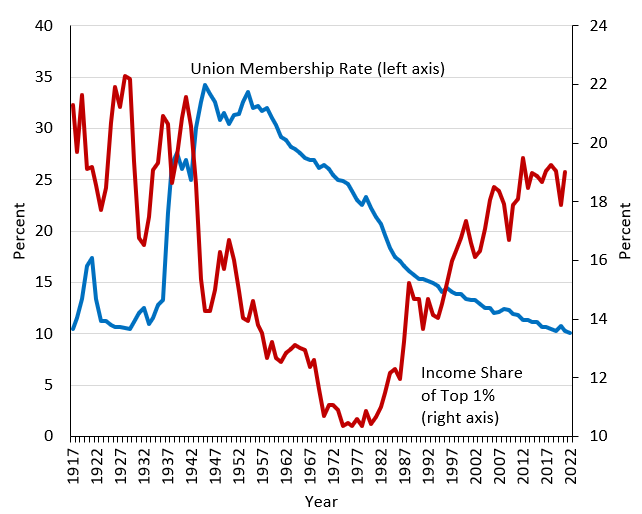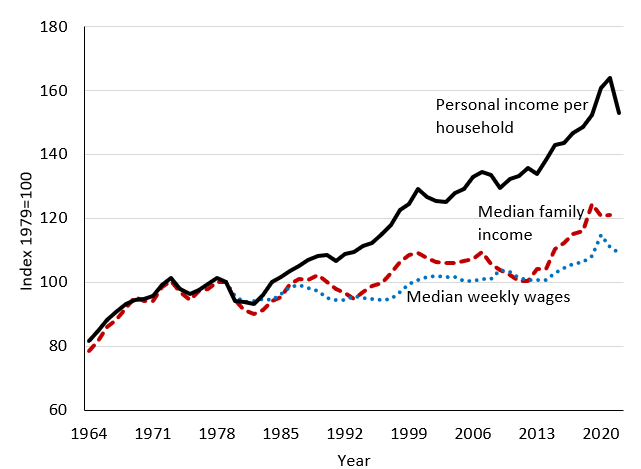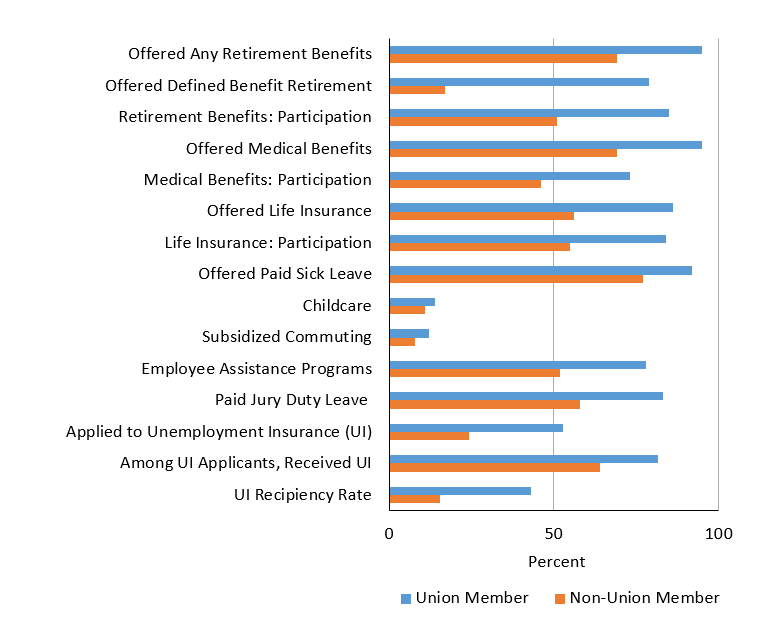By Laura Feiveson, Deputy Assistant Secretary for Microeconomics
Today, the Treasury Department released a first-of-its-kind report on labor unions, highlighting the evidence that unions serve to strengthen the middle class and grow the economy at large. Over the last half century, middle-class households have experienced stagnating wages, rising income volatility, and reduced intergenerational mobility, even as the economy as a whole has prospered. Unions can improve the well-being of middle-class workers in ways that directly combat these negative trends. Pro-union policy can make a real difference to middle-class households by raising their incomes, improving their work environments, and boosting their job satisfaction. In doing so, unions can help to make the economy more equitable and robust.
Over the last century, union membership rates and income inequality have diverged, as shown in Figure 1. Union membership peaked in the 1950s at one-third of the workforce. At that time, despite pervasive racial and gender discrimination, overall income inequality was close to its lowest level since its peak before the Great Depression, and was continuing to fall. Over the subsequent decades, union membership steadily declined, while income inequality began to steadily rise after a trough in the 1970s. In 2022, union membership plateaued at 10 percent of workers while the top one percent of income earners earned almost 20 percent of total income.
Figure 1: Union Membership and Inequality

While the overall U.S. economy has grown over the past few decades, the rise in inequality can be a proxy for the experience of many middle-class households. The income of the median family rose only 0.6 percent per year, in contrast to average personal income per household which rose 1.1 percent per year, as seen in Figure 2. And, notably, other markers of middle-class stability have deteriorated since the 1970s. Income has become more volatile,[1] the amount of time spent on vacation has fallen,[2] and middle-class Americans are less prepared for retirement.[3] Intergenerational mobility has declined—90 percent of children born in the 1940s earned more than their parents did at age 30, while only half of children born in the mid-1980s did the same.[4]
Figure 2: Income and Wage Growth since the 1960s

Source: Real median weekly wages from Bureau of Labor Statistics; nominal personal income from Bureau of Economic Analysis; real median household income from Census. All series are deflated by the Consumer Price Index
So, how could unions help? Treasury’s report shows that unions have the potential to address some of these negative trends by raising middle-class wages, improving work environments, and promoting demographic equality. Of course, unions should not be the only solution to these structural trends. But the evidence below and in the report suggests that unions can be useful in building the economy from the middle out.
Wages
One of the most oft-cited benefits of unions is the so-called “union wage premium”—the amount that union members make above and beyond non-members. While simple comparisons of the wages of union workers and nonunion workers find that union workers typically make about 20 percent more than nonunion workers,[5] economists turn to other types of analysis to capture causal effects of unions on wages. The first approach controls for many worker and occupation characteristics with the goal of comparing the wages earned by two similar workers that differ only in their union status. The other empirical approach is “regression discontinuity analysis,” which compares the wages in workplaces which just barely passed a vote to unionize against wages in workplaces that barely failed to pass the unionization vote. All in all, the evidence from these two approaches points to a union wage premium of around 10 to 15 percent, with larger effects for longer-tenured workers.[6]
Work environments
Worker wellbeing is greatly affected by non-wage benefits. Some benefits, such as healthcare benefits and retirement benefits, are a part of the compensation package and have substantial monetary value. Other features of the work environment, like flexible scheduling or workplace safety regulations, may not have direct monetary value but could still be highly valued by workers. For example, one study estimated that the average worker is willing to give up 20 percent of wages to avoid having their schedule frequently changed by their employer on short notice.[7] Another study, co-authored by Secretary Yellen, found that 80 percent of people who like their jobs cite a non-wage reason as the primary cause of their satisfaction and, conversely, 80 percent of people who dislike their jobs cite non-wage reasons to explain their dissatisfaction.[8]
There is strong evidence that unions improve both fringe benefits and non-wage features of the workplace. Figure 3 shows how much more likely it is for a union worker to be offered certain amenities than a nonunion worker. While these simple comparisons reflect correlations only, studies that use more robust empirical approaches find the same: unions have had a large hand in improving work environments on many dimensions and, in doing so, raise the wellbeing of workers and their families.[9]
Figure 3: Fringe Benefits and Amenities

Source: Bureau of Labor Statistics. UI data from 2018. Other data from March 2021. Offered benefits describe whether an employee has access to the benefit through their employer, no the take-up thereof. UI values include non-member workers represented by a union. UI recipiency rate is the percent of unemployed workers who received UI, irrespective of whether they are eligible for UI payments.
Workplace Equality
The diverse demographics of modern union membership mean that the benefits of any policy that strengthens today’s unions would be felt across the population.Union membership is now roughly equal across men and women. In 2021, Black men had a particularly high union representation rate at 13 percent, as compared to the population average of 10 percent.[10]
Unions promote within-firm equality by adopting explicit anti-discrimination measures, supporting anti-discrimination legislation and enforcement, and promoting wage-setting practices that are less susceptible to implicit bias. As an example of egalitarian wage-setting practices, single rate or automatic progression wage structures contribute to lower within-firm income inequality compared to firms that make individual determinations.[11] These types of practices, and others like publicly available pay schedules, benefit women and vulnerable workers who can be less likely to negotiate aggressively for pay raises.
Empirical studies have confirmed that unions have, indeed, closed race and gender gaps within firms. For example, one study finds that the wage gap between Black and white women was significantly reduced due to union measures.[12] Another study provides evidence of how collective bargaining has reduced gender wage gaps amongst teachers.[13]
Spillovers
The positive effects of unions are not limited to union workers. Nonunionized firms in competition with unionized workplaces may choose to raise wages, change hiring practices, or improve their workplace environment to attract workers.[14] Unions can also affect workplace norms by, say, lobbying for workplace safety improvements, or advocating for changes in minimum wage laws.[15] The empirical evidence finds that these positive spillovers exist. Each 1 percentage point increase in private-sector union membership rates translates to about a 0.3 percent increase in nonunion wages. These estimates are larger for workers without a college degree, the majority of America’s workforce.[16]
Unions may also produce benefits for communities that extend beyond individual workers and employers by enhancing social capital and civic engagement. Union members vote 12 percentage points more often than nonunion members, and nonunion members in union households vote 3 percentage points more often than individuals in nonunion households.[17] In addition, union members are more likely to donate to charity, attend community meetings, participate in a neighborhood project, and volunteer for an organization.[18]
Conclusion
Increased unionization has the potential to contribute to the reversal of the stark increase in inequality seen over the last half century. In turn, increased financial stability to those in the middle or bottom of the income distribution could alleviate borrowing constraints, allowing workers to start businesses, build human capital, and exploit investment opportunities.[19] Reducing inequality can also promote economic resilience by reducing the financial fragility of the bottom 95 percent of the income distribution, making these Americans less sensitive to negative income shocks and thus lessening economic volatility.[20] In short, unions can promote economy-wide growth and resilience.
All in all, the evidence presented in Treasury’s report challenges the view that worker empowerment holds back economic prosperity. In addition to their effect on the economy through more equality, unions can have a positive effect on productivity through employee engagement and union voice effects, providing a road map for the type of union campaigns that could lead to additional growth.[21] One such example found that patient outcomes improved in hospitals where registered nurses unionized.[22]
The Biden-Harris Administration recognizes the benefits of unions to the middle class and the broader economy and has taken actions, outlined in Treasury’s report, to empower workers. There have been promising signs: union petitions in 2022 rose to their highest level since 2015,[23] and public opinion in support of unions is at its highest level in over 50 years.[24] The evidence summarized here and in Treasury’s report suggest these burgeoning signs of strengthening worker power are good news for the middle class and the economy as a whole.





































